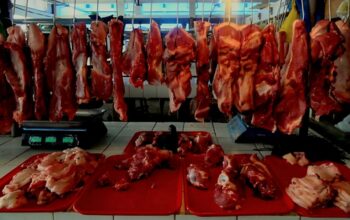
CORTES, Bohol (PIA)—Raw inflation in Bohol based on the monthly consumer price index increased from 3.8 percent last month to 4.0 percent, but the figure is still much lower than the inflation in February of 2023 which was at 9.4%.
With the re-based consumer price index for all income households from richest to poorest based in 2018, the purchasing power of a Philippine peso in Bohol now is about P122.90, when the 4.0 percent inflation rendered the peso then, at a market value now of P.81 centavos.
Based on the data presented by the Philippine Statistics Authority (PSA) during its regular monthly press conference at the PSA Office Friday, the local inflation rate is some 0.6 percent higher than the national inflation at 3.4, and still higher than 1.3 percent over the regional inflation rate which was at 2.7 percent.
Aside from Bohol’s increasing inflation rate, the same is noted in the entire country in general at 3.4 from 2.8 a month earlier and 2.7 percent from 2.5 percent recorded in Central Visayas las January.
Provincial Statisticain Jessamyne Anne Alcazaren pointed out the higher year-on-year crawl in transport registering 1.1 percent from -1.1 percent in January, plus a jump to 0.2 percent from a negative 0.6 percent in January 2024 and the 0.1 percent increase in inflation in restaurants and accommodations services at 7.8 from 7.7 in month prior, fed the uptrend.
Had not the inflation in food and alcoholic beverages tamed a bit, it would have been a much higher headline inflation for Bohol.
PSA noted the lower inflation in food and non-alcoholic at 6.7 percent from 7.2, alcoholic beverages and tobacco from 8.3 percent to 8.0 percent, clothing and footwear from 3.9 percent to 3.6 percent and other indices like furnishings, household equipment and routine household maintenance, health, recreation, sports and culture as well as personal care and miscellaneous goods and services all showing 0.1 percent declines, sobered the inflation rate.
The lower inflation rate as seen in foods and non-alcoholic beverages, restaurants and accommodation services and furnishings, household equipment and routine household maintenance, weighted down the provincial inflation rate.
Foods and non-alcoholic beverages comprise 67.1 percent share, restaurants and accommodation services get the 8.8 percent share and furnishings and household equipment and routine household repair and maintenance services owning up the 4.8 percent share already eating up the 80 percent of the inflation data pie.
In fact, according to the PSA, food inflation braked a bit to 7.0 percent from 7.5 percent in January of this year.
In Bohol, the slow movement of the price indices in slaughtered meat from 8.3 percent in January to 5.7 percent this month stalled the food inflation so well despite the scrimping supply with the local rice farmers scampering to get irrigation water to salvage the plants they risked planting off the regular season.
The rains in December and January this year pushed farmers to gamble considering that the El Niño is getting harder by the coming months and rice planting may not be a much viable option in the drought.
Indices in fruits and nuts also displayed a good price performance from 21.7 percent in January to 15.5 percent and fish and other seafoods from 2.2 percent to 1.4 percent. (rahc/PIA-7/Bohol)



